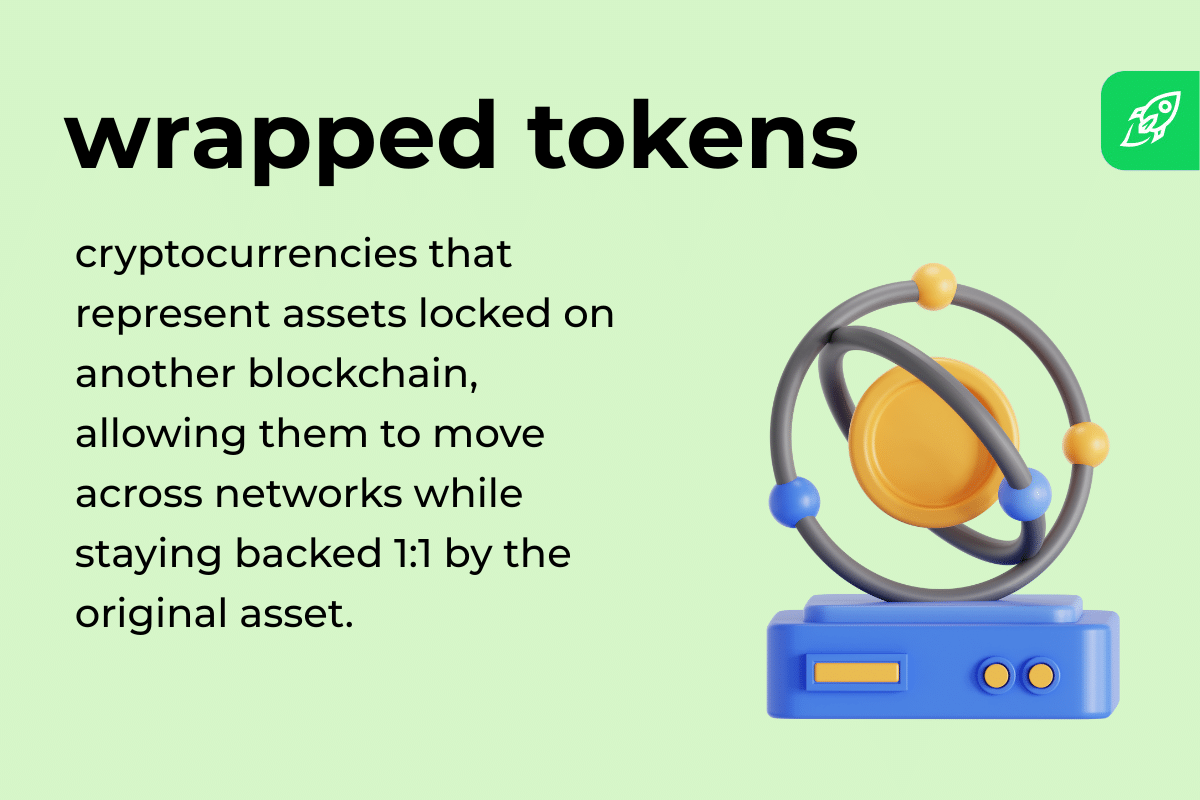Wrapped tokens are like superheroes in disguise. Bitcoin can put on an Ethereum cape, and suddenly become wrapped Bitcoin. It lets your favorite coins show up in places it wasn’t built to go. So keep reading if you’ve ever wondered exactly how wrapped tokens work, and we’ll explain what they are, why they exist, where they’re useful, what risks come with them, and how they fit into the bigger crypto market.
Table of Contents
What Is Wrapped Crypto?
Wrapped crypto is a tokenized version of one cryptocurrency that’s minted on a different blockchain. It is pegged 1:1 to the original asset and backed by reserves locked in smart contracts or vaults. This means each wrapped token always mirrors the value of the original coin, even though it moves and functions on another chain. Wrapped crypto tokens enable cross-chain interoperabixxlity by bridging blockchains that can’t otherwise work together.
Bitcoin, for example, was not designed to work with Ethereum’s decentralized finance apps. By wrapping it, users can bring BTC into Ethereum and use it for trading, lending, or yield farming, while still keeping its original value. The process relies on a lock-and-mint mechanism: the native asset is locked by a custodian, and an equivalent wrapped version is minted on the new blockchain.

How Wrapped Crypto Works
Understanding wrapped tokens starts with figuring out how they work. They lock an underlying asset—like BTC or ETH—on one chain and issue a matching token on another, usually using the ERC-20 Token Standard.
Let’s take a look at each step of that process in more detail.
- Locking mechanism
First, native coins are deposited into a secure collateral reserve, which is managed by a custodian. The tokens stay locked until their wrapped versions are redeemed. This locking mechanism is a crucial part of how wrapped tokens ensure every asset is fully backed, pegged 1:1 to the original.
- The wrapping process: minting, burning, and redeeming
Once assets are locked, wrapped tokens are minted and issued to the user on a different blockchain network. To release the original, the wrapped tokens must be burned, removing them from circulation. Only then can the custodian redeem the native asset from the reserve. This sequence keeps supply balanced and guarantees every wrapped token can be exchanged 1:1.
- Roles of the custodian and token issuer
Two main actors enable the cycle: the custodian, who holds the underlying assets, and the token issuer, usually operating through a cross-chain bridge. The bridge locks the coins and issues wrapped versions under the ERC-20 standard, enabling cross-chain interoperability.
- Security measures: Proof of Reserves and multi-signature wallets
To build user trust, Proof of Reserves confirms that every wrapped token is matched by a real asset, often through cryptographic audits. Multi-signature wallets add another safeguard by requiring multiple approvals before funds can move. Together, these measures maintain transparency and reduce risks, making managing wrapped tokens safer for both custodians and users alike.
Why Wrapped Tokens Are Useful in Crypto and DeFi
Blockchains don’t usually talk to each other, and wrapped tokens help them bridge this gap. They make cross-chain interoperability real, and the results are obvious. Let’s look at the details.
- Unlocking DeFi opportunities for non-native assets.
A plain old bitcoin can’t join Ethereum’s DeFi party. But wrap it into WBTC, and suddenly it’s lending on Aave, trading on Uniswap, or farming yield like it was born there. Wrapped tokens give “outsider” assets a chance to earn, trade, and participate in ecosystems that would otherwise be off-limits.
- Liquidity pools, yield farming, and lending.
By converting non-native digital assets into local ERC-20s (or their equivalents), wrapped tokens can slot into liquidity pools, support lending markets, and supercharge yield farming. In this way, wrapped tokens increase liquidity across decentralized finance (DeFi) by unlocking more assets for use.
- Cross-chain Bridge as the gateway to DeFi ecosystems.
Cross-chain bridges act as portals between different blockchain networks, and wrapped tokens are what you carry through them. If you want your AVAX earning on the Ethereum blockchain, or your BTC farming on Polygon, wrapping makes that all possible.
Types of Wrapped Tokens
Lock-and-Mint Model vs. Burn-and-Release Model
The lock-and-mint model is the standard: a custodian or program locks the original token, while a wrapped version is minted on another chain. Redemption reverses the process—the wrapped token is burned, and the original is released. This is how Wrapped Bitcoin (WBTC) can work on the Ethereum blockchain.
In contrast, the burn-and-release model destroys tokens on one chain before unlocking them on another. Used by bridges like RenBridge, it prevents inflated supply and keeps balances consistent. RenBridge, for instance, used this model to move Bitcoin into Ethereum, maintaining parity without permanent locks.
Both approaches solve the same problem, but have different models of trust: one relies on custodians, the other on bridge protocols.
Centralized vs. Decentralized Models
Wrapped tokens also split along governance lines. Centralized systems put custodians or trusted institutions in charge of holding reserves and minting wrapped assets. They provide efficiency and regulatory clarity but hinge on the credibility of the custodian.
Decentralized systems use distributed networks or smart contracts to manage custody without a single point of control. Projects like RenVM tried this route, replacing institutional trust with validator consensus. While attractive for censorship resistance, these setups face scalability and security hurdles which we will explore below.
In practice, most high-volume wrapped tokens remain centralized. They scale more reliably, while decentralized versions are still experimental. The trade-off is straightforward, though: more stability for less sovereignty.
What Is the Difference Between Wrapped and Unwrapped Coins?
Unwrapped coins are the originals, while wrapped coins are copies adapted to live on another chain. Let’s break down their exact differences.
| Feature | Wrapped Coins | Unwrapped Coins |
| Definition | Copies of the base assets adapted to another chain | Base layer assets that exist on their native blockchain |
| Environment | Issued on a different chain but pegged 1:1 to the original | Run on their own consensus rules, miners/validators, and blockchains |
| Value Basis | Tied to the original asset but usable across ecosystems | Directly tied to the security and consensus of the underlying network |
| Unique Role | Unlocks cross-chain use, e.g., BTC in Ethereum DeFi or ETH in ERC-20 smart contracts | Every transaction strengthens the security of its native blockchain |
| Examples | Wrapped Bitcoin (WBTC), Wrapped Ether (WETH) | Bitcoin (BTC), Ether (ETH) |
Popular Wrapped Cryptocurrencies
- Wrapped Bitcoin (WBTC)
Wrapped Bitcoin Tokens bring Bitcoin into the Ethereum blockchain, trading as a fully backed ERC‑20 asset. It trades 1:1 with BTC but lets you tap into DeFi, lending, and trading pools. - Wrapped Ether (WETH)
WETH exists to solve a simple technical issue: ETH itself isn’t an ERC-20 token, which makes it awkward to use across many Ethereum-based applications. Wrapping ETH into WETH standardizes it, enabling seamless interaction with smart contracts, DeFi protocols, and decentralized exchanges. - Wrapped BNB (WBNB)
WBNB lets BNB join DeFi on BNB Smart Chain by making it function like a BEP‑20 token. It’s essential in DEX trading and liquidity strategies, turning BNB into a versatile asset that DeFi platforms can easily handle. - renBTC
renBTC is Bitcoin that crossed into Ethereum without a central custodian. All of it is handled by RenVM’s decentralized node network, so no single company holds the keys. - HBTC (Huobi BTC)
HBTC is Bitcoin wrapped by Huobi exchange. It’s 1:1 backed and used within both Huobi’s ecosystem and broader Ethereum DeFi, relying on Huobi’s reserves. - Wrapped AVAX (WAVAX)
WAVAX turns Avalanche’s native token into an ERC‑20 version, so it fits in DeFi across Avalanche’s C‑Chain. It trades 1:1 with AVAX and powers DEXs, lending platforms, and yield pools on Avalanche - Wrapped MATIC (WMATIC)
WMATIC wraps Polygon’s native token into an ERC-20, making it usable in Ethereum-compatible DeFi systems. It’s a workhorse for liquidity, lending, and more on Polygon, essentially giving MATIC a broader passport.

How to Get Free Crypto
Simple tricks to build a profitable portfolio at zero cost

How Wrapped Crypto Is Used (Real Examples for Beginners)
Wrapped tokens move, trade, borrow, and bridge across chains. Here’s how they’re actually put to work in the crypto space.
- Lending and Borrowing with Wrapped Tokens.
Wrapped tokens make crypto loans easier. On platforms like Aave, you can deposit WBTC as collateral and borrow USDC or DAI without selling Bitcoin. This lets you keep your BTC exposure while unlocking liquidity. - Trading and DEX Usage.
By wrapping Bitcoin into WBTC, you can swap it on decentralized exchanges (DEXs) like Uniswap or SushiSwap, which run entirely on code, without central intermediaries. Since wrapped tokens follow the ERC-20 Token Standard, they plug seamlessly into DEX liquidity pools. - Collateral in DeFi (e.g., Stablecoin Loans).
Wrapped tokens make excellent collateral. On platforms like Compound, for example, WBTC can be locked to mint DAI, letting you generate stablecoins without selling your crypto. It means you can hold BTC’s upside while still getting liquidity, an obvious win-win. - Bridging Assets Across Blockchains.
Wrapped tokens work like the bridge tickets between chains. Want to take your AVAX to Ethereum, or vice versa? Bridge it, and it shows up as a wrapped token on the new chain. Though bridges are also hacker magnets, when used correctly, they’re powerful connectors in a multichain world.
Pros and Cons of Wrapped Crypto
The benefits of wrapped tokens, like making digital assets more versatile, come with some trade-offs. Here are the details.
| Pros | Cons |
| Cross-chain flexibility: Lets BTC and others run on Ethereum and join DeFi. | Centralization risk: Custodial models like WBTC rely on third parties. |
| Liquidity boost: Adds depth to DEX pools, improving trade speed and spreads. | Liquidity risk: If pools shrink, trading and borrowing get harder. |
| Collateral utility: Works as collateral in lending protocols like Aave. | Regulatory risk: May face KYC/AML limits or restrictions. |
| Yield access: Non-native assets can earn rewards on DeFi platforms. | Extra costs: Wrapping, bridging, and farming bring more fees. |
| Faster trading: DEX swaps avoid long blockchain settlement times. | Smart contract risk: Bugs in bridges or wrappers can cause losses. |
| Interoperability: Bridges and wrapped tokens connect ecosystems. | Custodian trust: Users must rely on custodians’ 1:1 backing claims. |
Wrapped Tokens vs. Synthetic Assets
Wrapped tokens offer 1:1 backing by their original asset, while synthetic assets track the value of an asset without actually holding it in reserve. Here’s how they compare.
| Feature | Wrapped Tokens | Synthetic Assets |
| Backing | Collateralized 1:1 by the underlying asset (e.g., WBTC backed by BTC). | Not backed directly, but by collateral and code that tracks price (e.g., sBTC on Synthetix). |
| Main Purpose | To bring non-native assets into a different blockchain (e.g., BTC on Ethereum). | To give exposure to asset prices (crypto, stocks, commodities) without ownership. |
| Custody Model | Relies on custodians or bridges to hold the original coins. | Managed by code and collateral pools, with no direct custody. |
| Risk Profile | Custodial or programming risk; depends on issuers and bridge security. | Higher contract and collateral risk; vulnerable to oracle issues. |
| Use Cases | DeFi trading, liquidity pools, lending, collateral for stablecoins. | Price speculation, derivatives, and hedging across asset classes. |
| Examples | WBTC, WETH, renBTC. | Synthetix (sUSD, sBTC, sETH), Mirror Protocol assets. |
Risks of Wrapped Tokens You Should Know
Wrapped tokens unlock DeFi opportunities, but they also carry risks linked to bridges, custodians, and code. Here are the main ones to watch:
- Smart contract exploits. Wrapped tokens rely on code, and flaws can be catastrophic. In 2022, for example, a bug in Wormhole let hackers mint 120,000 WETH (worth ~$320M) out of thin air, draining the protocol’s collateral.
- Bridge attacks. Since wrapped tokens often cross blockchains, bridges become prime targets. The Ronin Bridge hack in March 2022 proved this, when attackers stole over $600M in ETH and USDC.
- Custodian risk. Many tokens, like WBTC, depend on centralized custodians holding the original asset. If a custodian like BitGo were ever hacked, bankrupt, or forced to freeze funds, every WBTC holder would lose access to their value.
- Operational errors. Even when fixes exist, delays in applying them can be costly. In Wormhole’s case, developers had already uploaded a patch for the bug, but never deployed it, leaving the door open for the exploit.
- Regulatory pressure. Because custodians are central points of control, they’re exposed to laws and regulators. If authorities force them to halt redemptions or freeze assets, wrapped token holders could suddenly find themselves stuck.
Are Wrapped Tokens a Good Investment?
Wrapped tokens aren’t really investments in their own right, since they don’t generate value beyond the original asset they mirror. Instead, their strength lies in utility: they make it possible to use coins across different ecosystems, access DeFi features, and put otherwise limited digital assets to work.
If you want to actively use your crypto in DeFi or across multiple chains, wrapped tokens are the way to go. But if your goal is price speculation, there’s little reason to choose them over the native asset.
The Future of Wrapped Crypto
Wrapped tokens work and grow because blockchains remain fragmented. They solve a simple but important problem: letting assets move where they normally can’t. As more DeFi projects expand and Layer 2 networks mature, wrapped tokens act as the bridges that make these ecosystems work together. Innovation could change how wrapping happens, though. It already has. Trust-minimized bridges, like Chainlink’s Cross-Chain Interoperability Protocol, aim to reduce dependence on custodians, while regulators may push for more transparency and security after high-profile exploits.
The future won’t have no wrapped tokens, but they will be safer, more automated, and firmly embedded into mainstream DeFi infrastructure.
Final Thoughts: Should You Use Wrapped Tokens?
Yes—if you care about utility, not speculation. Wrapped tokens aren’t moonshots, but they’re the passport that lets your crypto move across blockchains and plug into decentralized finance (DeFi). Use them for lending, liquidity, or cross-chain trading, but keep the risks in mind. At the end of the day, they’re tools, not treasures.
FAQ
Is it safe to buy Wrapped Bitcoin?
Wrapped Bitcoin tokens are generally safe if you use trusted platforms, since they’re backed 1:1 by real BTC held by custodians. However, risks still exist, from potential hacks or custodian failures. Always research the provider before buying.
Why can’t I just use Bitcoin directly on Ethereum?
Bitcoin and Ethereum are built on separate blockchains that can’t normally interact with each other. Wrapping BTC creates a version that works with Ethereum’s smart contracts. This makes it possible to use BTC in DeFi apps like lending or DEXs.
Is wrapped crypto backed 1:1 by the original asset?
Yes, most wrapped tokens are backed 1:1 by the underlying crypto, which is locked up by custodians or code. This ensures price parity with the real asset. Still, though, it also relies on trust in whoever holds the reserves.
Can I unwrap my wrapped tokens anytime?
In most cases, yes. The process may involve using a bridge or custodian service and paying a small fee. Availability depends on the platform managing the asset.
What risks exist when minting or redeeming?
The main risks come from programming bugs, hacks on bridges, or custodians losing funds. These events can cause delays or losses when converting between wrapped coins and the originals. That’s why picking a reliable provider is so important.
Do I need a special wallet for wrapped tokens?
No special wallet is needed. As long as your current wallet supports the blockchain where the wrapped coin lives (like Ethereum for WBTC), you can store and use it. Just be sure you select the correct network when sending or receiving.
Can wrapped tokens be used outside Ethereum?
Yes, wrapped coins now exist on many blockchains beyond Ethereum, including Polygon, BNB Chain, and Solana. This allows users to move liquidity and use their assets across ecosystems. Wrapping helps bridge value between otherwise isolated networks.
Disclaimer: Please note that the contents of this article are not financial or investing advice. The information provided in this article is the author’s opinion only and should not be considered as offering trading or investing recommendations. We do not make any warranties about the completeness, reliability and accuracy of this information. The cryptocurrency market suffers from high volatility and occasional arbitrary movements. Any investor, trader, or regular crypto users should research multiple viewpoints and be familiar with all local regulations before committing to an investment.


